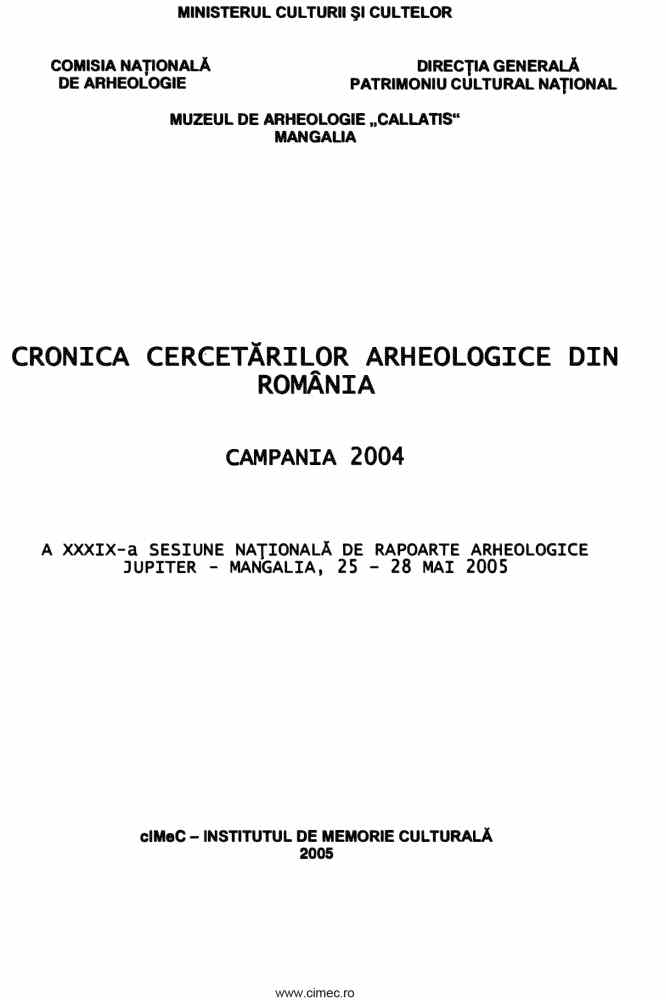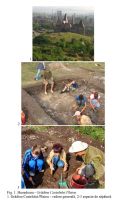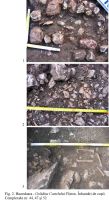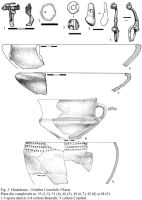Instituții și
Persoane implicate:
| Nume |
Prenume |
Rol |
Instituție |
| Orlandea |
Eugen |
participant |
Instiuție Nedefinită |
| Soficaru |
Andrei |
participant |
Institutul de Antropologie "Francisc J. Rainer" Bucureşti |
| El Susi |
Georgeta |
participant |
Institutul de Arheologie "Vasile Pârvan", Bucureşti |
| Sîrbu |
Valeriu |
responsabil |
Muzeul Brăilei |
| Cerişer |
Nicolae |
participant |
Muzeul Castelul Corvineştilor, Hunedoara |
| Roman |
Cristian Aurel |
participant |
Muzeul Castelul Corvineştilor, Hunedoara |
| Luca |
Sabin Adrian |
participant |
Universitatea "Lucian Blaga", Sibiu |
| Purece |
Silviu Istrate |
participant |
Universitatea "Lucian Blaga", Sibiu |
Raport:
Zona cu descoperiri se află pe un platou din calcar dolomititc (dom stâncos), cotă maximă 290 m, situat în grădina Castelului Corvineştilor.
Au fost cercetate un număr de 13 suprafeţe: S18, 21, 22, 30 = 4x4 m; S20, 26, 27 = 4x3 m; S19 = 4,5x4 m; S23 = 3x3 m; S 24 = 4x3,8 m; S 29 = 6x3 m; S 28 = 5x5 m; S 25 = 6x3 m. Există ridicare topografică, iar materialul este recoltat şi notat, pe pachete ori individual, cu un singur număr de identificare. În campaniile 2001-2002 săpăturile s-au efectuat în secţiuni şi casete, iar din 2003 se execută suprafeţe, de obicei de 4x4 m.
Locul unde se află vestigiile este reprezentat de un "dom stâncos" din dolomită, cu aspect accidentat, datorită acţiunii factorilor naturali de-a lungul epocilor geologice, uneori stânca ajungând la suprafaţă. Platoul este brăzdat de fracturi tectonice cvasiparalele pe două direcţii diferite şi are numeroase cuvete, unele cu forme aproape regulate, datorită dezagregării muntelui de dolomită.
Ca urmare a factorilor naturali, stratigrafia geologică, peste stânca nativă din dolomită, prezintă trei straturi, menţionate de bază spre suprafaţă: a) strat de roci dolomitice sfărâmate, mai albicioase spre bază, datorită conţinutului de calcar din roca nativă, amestecate cu pământ, b) strat de pământ cu mici fragmente de rocă dolomitică şi c) strat "vegetal", format din sol şi praf industrial. Grosimea maximă a acestor depuneri, acolo unde stânca nu ajunge la suprafaţă, poate atinge 0,6 m, desigur date valabile pentru zona săpată până acum. În antichitate platoul se prezenta, foarte probabil, ca o zonă foarte accidentată, formată din piscuri, cuvete şi dolomită sfărâmată, neacoperită de strat un vegetal continuu, cu depuneri de pământ doar în locurile adâncite. Surprinzător e faptul că în cuvetele naturale cele mai adânci, unele de 0,4-0,5 m, şi cu forme aproape regulate pe anumite laturi, nu s-au înhumat copii, deşi acestea erau cele mai propice. De asemenea, pentru nici una dintre înhumările de copii nu s-a săpat vreo groapă. Observaţiile de până acum indică faptul că înhumările de copii s-au făcut în acest strat de dolomită sfărâmată, ele fiind apoi acoperite tot cu rocă spartă. Întrucât nu există suprapuneri şi nici întretăieri între aceste înhumări, fie ele s-au făcut într-un interval foarte scurt, fie au existat anumite semne la suprafaţă.
În campania din 2004, au fost identificate 18 complexe, după cum urmează: cultura Coţofeni – 1, cultura Basarabi – 6, epoca dacică – 10, epoca medievală – 1.
Complexul 40, Aglomerarea 1, S20-C, epoca dacică (sec. I p. Chr): aglomerare de oase de animale, de mamifere mici şi mari, unele cu urme de tăiere, găsite într-o amenajare de dolomită spartă, de formă aproape rotundă (diametru = 0,8 m), aflată la adâncimea de -0,23-0,26 m.
Complexul 42, Depunerea 7, S21-D, cultura Basarabi: depunere de formă neregulată, pe o suprafaţă de cca. 0,4x0,25 m, aflată la adâncimea de -0,15–0,25 m, constituită din vase şi fragmente de vase Basarabi, unele sparte in situ, plus un vârf de săgeată din corn de cerb în curs de prelucrare.
Complexul 44, Scheletul 21, S20-B, epoca dacică (sec. I p. Chr): într-o amenajare de formă aproape rectangulară (diametru = 0,45–0,25 m), aflată într-un strat de dolomită sfărâmată, formată din pietre rulate ori dolomită sfărâmată, mai mari în zona depunerii oaselor craniene, la adâncimea de 0,39–0,41 m, s-au mai păstrat un fragment de parietal dreapta şi un fragment de arc vertebral de Infans I. Este evident vorba de o amenajare în care s-au aflat doar oase dintr-un schelet de copil, deranjările ulterioare afectând doar partea superioară a complexului, în nici un caz aici n-a fost înhumare normală (la cca. 1 m N de complex s-au mai găsit două fragmente de craniu de la un copil mic (Infans I).
Complexul 47, Scheletul 22, S18-A, epocă dacică (sec. I p. Chr): înhumarea s-a făcut aproape pe stânca nativă, dar pe un strat subţire de pământ, la adâncimea de -0,37-0,42 m, în jur fiind pietre masive, unele rulate, îndeosebi în zona capului şi a şirei spinării. Defunctul, copil de cca. 18 luni, a fost depus pe stânga, cu capul spre NNV, corpul uşor curbat, cu genunchii în faţă. Apreciem că a fost depus întreg şi în ordine anatomică, lipsa unor oase, îndeosebi din zona picioarelor, se datorează deranjărilor ulterioare. Inventar: mărgică alburie, lângă cotul drept. Ofrande (?): oase de la o ovicaprină şi o vită.
Complexul 48, Depunerea 1, S28-D, cultura Coţofeni: pe o zonă de cca. 0,45x0,3 m, la adâncimea de -0,1–0,2 m, peste şi în stratul de dolomită spartă, s-au găsit părţi din două vase sparte in situ; este cert vorba de vase sparte pe loc, fapt observat stratigrafic, dar, din păcate, fiind aproape de suprafaţă şi în pantă, o parte din fragmente au fost dislocate şi au dispărut. Sunt două castroane mari, cu gura invazată, decorate cu impresiuni adânci, ovale, aranjate pe trei şiruri orizontale imediat sub buza vaselor.
Complexul 52, Scheletul 25, S25-C-D, epocă dacică (sec. I p. Chr): înhumarea s-a făcut într-o cuvetă existentă în dolomită, înclinată de la N spre S, scheletul aflându-se acum la adâncimea de -0,35–0,4 m. Copilul, în vârstă de cca. 6 ani, a fost aşezat în decubit dorsal, cu capul spre E şi privirea spre N; avea picioarele flexate, cu tălpile duse spre spate.
Complexul 53, Scheletul 26, S21-D, epocă dacică (sec. I p. Chr): înhumarea s-a făcut într-o alveolare existentă în dolomită, dar pe un strat de pământ cu dolomită fărâmiţată, acum scheletul aflându-se la adâncimea de -0,15–0,23 m. Copilul, în vârstă de cca. 5 ani, a fost depus în decubit dorsal, cu capul spre VNV, cu privirea în sus, mâinile, uşor îndoite din coate, aveau palmele pe şolduri, picioarele fiind uşor spre dreapta, cu genunchii puţin îndoiţi. Inventar: două fibule din bronz, aflate pe umeri, doi cercei din bronz la urechi şi trei mărgele în zona capului.
În toate cazurile, după cum a rezultat din datele observate în teren, a fost vorba de înhumări de copii şi depuneri intenţionate de piese şi materiale. Până în prezent, deci în toate campaniile de săpături, pe platoul din Grădina Castelului nu s-a descoperit nici un complex de locuire in situ. De altfel, datorită aspectului extrem de accidentat al muntelui de dolomitiă, cu piscuri, cuvete şi roci dezagregate, pentru locuire erau necesare ample lucrări de amenajare, fie prin terasări, fie prin nivelări cu pământ adus, fapt ce nu s-a constatat nicăieri în zona săpată până acum.
Trebuie menţionat că multe complexe au fost distruse, iar o parte din cele rămase au fost serios afectate de lucrările desfăşurate de-a lungul timpului întrucât descoperirile se află lângă castel. E de menţionat, însă, că toate complexele descoperite aici reprezintă depuneri intenţionate, întrucât ele nu provin din complexe de locuire in situ şi nici n-au putut ajunge aici întâmplător, adică prin rulare, alunecări, torenţi etc.
Cultura Coţofeni. S-a descoperit, până în prezent, un singur complex din această epocă (C48) şi acela distrus în mare măsură, astfel că nu se pot face nici un fel de consideraţii de ordin general.
Cultura Basarabi. S-au descoperit 6 complexe din această perioadă, trei sub forma unor aglomerări de oase de animale şi fragmente de vase, într-un caz şi cu rare bucăţi de vatră (C39, C41 şi C49), unul de fragmente de vase (C54), unul de vase sparte in situ, plus un vârf de săgeată din corn în curs de prelucrare (C42), plus o alveolare (C56). Menţionăm că în campania din 2003 aici au fost descoperite depuneri de vase întregi ori sparte in situ, uneori cu bucăţi de vetre cu gardină, în două cazuri fiind şi oase umane izolate, neincinerate, de astă dată de maturi. E de menţionat că, spre deosebire de epoca dacică, numărul vaselor şi fragmentelor de vase de tip Basarabi este mai numeros. Din păcate, nivelul cu depuneri Basarabi a fost puternic afectat de cel de epocă dacică şi de distrugerile ulterioare.
Epoca dacică. Ca şi în campaniile anterioare, cele mai numeroase şi mai importante descoperiri aparţin acestei epoci, perioadă din care s-au identificat 10 complexe: înhumări de copii – 7, aglomerări de materiale – 2, depuneri de piese – 1. În toate cazurile este vorba de copii mici (Infans I), de la nou-născuţi până la cei cu vârsta de 5-6 ani, aşa cum rezultă din analizele preliminare efectuate de Andrei Soficaru şi Adriana Stan. Este vorba, de obicei, de înhumări de copii întregi şi în ordine anatomică, dar nu s-au sesizat reguli de depunere şi orientare. În două cazuri, însă, s-au găsit doar câteva fragmente de cranii şi câteva oase post-craniene, în depuneri precis delimitate, astfel că lipsa restului scheletului nu poate fi pusă doar pe distrugerile ulterioare (C43 şi C44). De regulă, în cazul înhumărilor de copii întregi şi în ordine anatomică s-a găsit inventar, anume podoabe şi accesorii vestimentere (fibule, mărgele, pandantive), lipsind total, ca şi în campaniile anterioare, vasele ceramice. Pe baza inventarului, toate descoperirile de copii se datează în sec I p. Chr. S-a descoperit şi o depunere de piese de podoabă, inclusiv fibule din fier, de astă dată, însă, din sec II a. Chr (C46). Amintim că aici s-au mai descoperit depuneri de piese, toate pe marginea de SE a zonei cu înhumări de copii şi datând din sec. I p. Chr, de obicei podoabe şi accesorii vestimentare, care nu sunt în legătură directă cu vreo anume depunere umană. Caracterul intenţionat al acestor depuneri de bunuri este indiscutabil, el fiind demonstrat atât de modul cum s-au găsit ele, cât şi de compoziţia lor. Vrem să precizăm că în zona cu înhumări de copii nu s-au găsit, cu câteva excepţii, vase ori fragmente de vase ceramice din epoca dacică.
Rezumat:
Zona cu descoperiri (necropolă de inhumaţie) se află pe un platou din calcar dolomititc (cotă maximă 290 m) situat în grădina Castelului Corvineştilor.
În campania din 2004, au fost identificate 18 complexe, după cum urmează: cultura Coţofeni – 1, cultura Basarabi – 6, epoca dacică – 10, epoca medievală – 1.
Mormintele par să fie grupate, orientate pe direcţia SE-NV, defuncţii depuşi pe spate.
Majoritatea defuncţilor fiind copii, nu este posibilă stabilirea poziţiei exacte a unor schelete datorită degardării accentuate a oaselor. Unii copii au fost depuşi întinşi pe spate, alţii chirciţi pe dreapta, alţii pe stânga, uneori acoperiţi cu pietre. Poziţia capului urmăreşte, de cele mai multe ori, punctele cardinale. În unele cazuri este evidentă absenţa unor părţi anatomice (membre) şi chiar a capului. Inventarul este bogat şi variat, dar cu unele caracteristici depinzând nu doar de individ ci şi de nucleul familial de care aparţine.
În cazul înhumărilor de copii inventarul constă din podoabe şi accesorii vestimentere (fibule, mărgele, pandantive), lipsind total, ca şi în campaniile anterioare, vasele ceramice. Pe baza inventarului, toate descoperirile de copii se datează în sec I p. Chr.
Mormintele cercetate până în prezent – 26 de complexe cu peste 30 de indivizi – au caracteristici unice şi curioase pentru lumea geto-dacă:
a. toţi defuncţii sunt copii (infans 1);
b. nu există o regulă de dispunere a defuncţilor;
c. Inhumaţia este ritul funerar practicat;
d. sunt schelete cu părţi anatomice lipsă;
e. gropile nu au fost săpate în piatră, dar au fost folosite cavităţile deja existente;
f. aparentul paradox între inventarul corporal bogat şi lipsa inventarului ceramic;
g. depunerea de arme lângă scheletul unor copii foarte mici.
Până în prezent, deci în toate campaniile de săpături, pe platoul din Grădina Castelului nu s-a descoperit nici un complex de locuire in situ.
Caracterul intenţionat al depunerilor de bunuri este indiscutabil, el fiind demonstrat atât de modul cum s-au găsit ele, cât şi de compoziţia lor. În zona cu înhumări de copii nu s-au găsit, cu câteva excepţii, vase ori fragmente de vase ceramice din epoca dacică.



 CC BY-SA 4.0
CC BY-SA 4.0 

